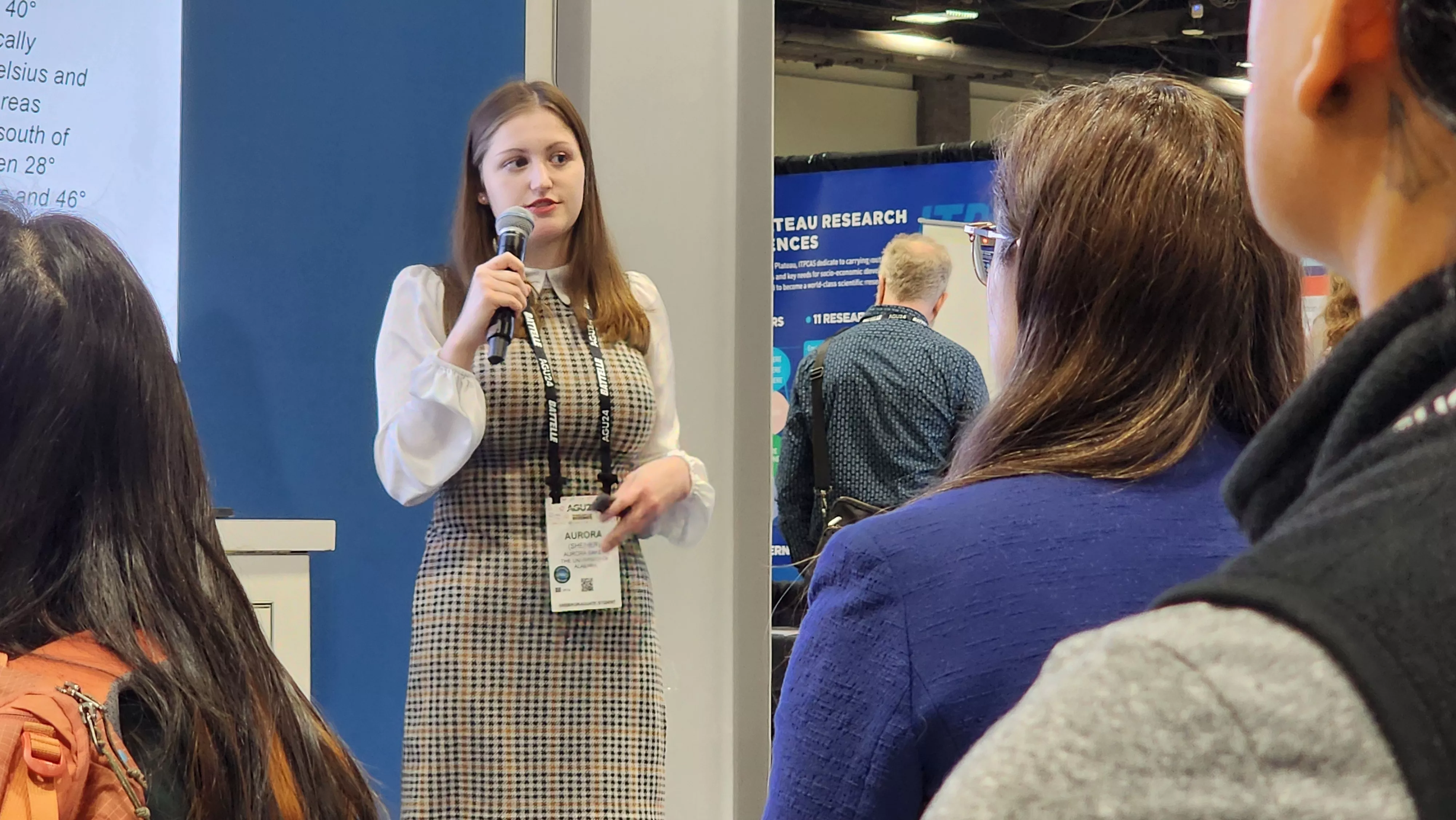NOAA is helping to connect science with education to inspire the next generation of scientists. Through NOAA’s Data in the Classroom program, middle and high school students can explore real-world environmental topics using historical and real-time NOAA data from satellites and other systems. The program offers five modules, each designed to help students ask questions, challenge assumptions, interpret data, and think critically about the world around them.

NOAA Earnest F. Hollings Undergraduate Scholar, Aurora Baker, presented her work on NOAA's Data in the Classroom at the 2024 American Geophysical Union (AGU) annual meeting in Washington, D.C.
Environmental data isn’t just for scientists and researchers—it’s a powerful tool for educators to inspire the next generation of critical thinkers and problem solvers. At the 2024 American Geophysical Union (AGU) annual meeting in Washington, D.C., NOAA Earnest F. Hollings Undergraduate Scholar, Aurora Baker, addressed this opportunity head-on. Her presentation, “Tackling the ‘Last Mile’: How NOAA’s Data in the Classroom Is Bridging the Gap Between Earth Science Open Data and the Needs of Educators," focused on how to turn vast, complex datasets into resources that are practical, accessible, and useful for educators.
During her internship with NOAA’s National Environmental Satellite, Data, and Information Service (NESDIS), Baker worked to modernize the Data in the Classroom program. She focused on bridging the “last mile”—the often-overlooked step of adapting scientific resources and tools for classroom use, so educators and students can easily access and explore NOAA’s data without needing advanced expertise.
Baker’s work highlights an important lesson: Accessibility should not be an afterthought; it is a core component of effective educational resources. To truly serve diverse users, educational resources must be designed with intention, ensuring that they meet the needs of teachers and students from the start to complement learning goals and a range of other curricular resources about Earth science.
Listening to Educators and Students: Collaboration as a Foundation
Baker stressed the importance of collaboration in developing effective educational tools. She explained that listening to educators and students through user testing and feedback is essential for success.
“Through alignment with learning goals and course curriculum, curated open data sets, functional tools, and increased accessibility, Data in the Classroom effectively bridges this last mile between open data and the needs of educators,” she explained.
For scientists and developers, this means gathering meaningful feedback through focus groups, surveys, or pilot testing. Tools work best when they are shaped by the people who will ultimately use them.
Making Science Work for Classrooms: Bridging the ‘Last Mile’
Baker emphasized the importance of designing tools that meet the realities of today’s classrooms. To create resources that truly make a difference, she explained that scientists and developers must align their tools with existing curricula, standards, and learning goals. They also need to consider practical challenges and classroom constraints, such as limited technology and varying levels of IT infrastructure.
Her primary message to scientists is that they must understand what teachers need and what tools they have in order to create resources that weave real-world data into their lessons seamlessly.
Improving Usability and Accessibility: Designing for the End User
In modernizing Data in the Classroom modules, Baker replaced outdated tools with more user-friendly, interactive options. For example, she updated Esri StoryMaps with tools that were faster, easier to navigate, and more intuitive. These improvements allowed teachers and students to spend less time figuring out the interface and more time learning the science.
To ensure broader accessibility, Baker also added features such as descriptive alt-text for images and clearer heading structures for screen readers. These updates made the tools more inclusive, opening the door for more students to engage with NOAA’s data.
Turning Data into Discovery
“Satellite data isn’t just numbers or graphs,” Baker explained. “It’s a way to tell stories about the Earth and its systems.” By giving students the tools to explore these stories, NOAA inspires them to think like scientists and tackle real-world opportunities.
Baker offered three key takeaways for creating effective educational tools:
- Focus on the specific needs of teachers and students.
- Prioritize usability and accessibility by designing tools that are intuitive and inclusive from the start.
- Create tools that are practical and easy for educators to use in classrooms.
Baker’s work demonstrates how well-designed resources can transform complex data into powerful learning experiences. By putting data into students’ hands, NOAA is empowering young learners to think like scientists to explore Earth science, think critically, and find solutions to real-world environmental challenges of today and tomorrow.
